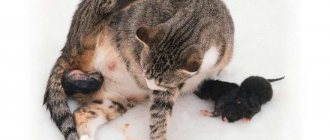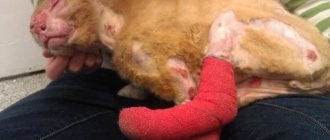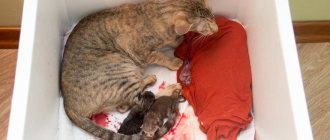The approaching birth of a cat causes anxiety for both the animal and the owner. After seven weeks, the veterinarian indicates the exact date of birth, which allows you to properly prepare for it. Possession of information about the stages of labor, calmness and support for the animal contribute to a favorable outcome and well-being of the mother and kittens.
At what age do cats give birth?
From 7 months, the cat begins to be interested in the opposite sex and becomes sexually mature. If you want to get healthy offspring, veterinarians advise breeding the animal during its second heat.
Cats can give birth until old age, but pet owners should stop their pet’s sex life in time so that the quality of the offspring and the health of the cat are not affected. After all, when abusing a cat’s ability to give birth, people often think only about their own wallet. Thus, to avoid problems, veterinarians recommend spaying or neutering an animal at the age of 6-7 years.
How to tell if your cat is pregnant
Signs of pregnancy in a cat can be observed 3 weeks after conception. Some people who let their cats go outside can track this period on a calendar (as a rule, the cat does not spend the night at home and does not appear in front of its owners for 3-4 days). Those owners who specifically breed a cat with a cat can also calculate whether the cat is pregnant. We will tell you further how many months you will have to wait for a replenishment. The most difficult thing to predict pregnancy is for those owners whose cat walks outside on its own.
You can determine that a cat is pregnant by the following signs:
- the cat’s appetite has changed: it happens that favorite treats remain untouched, and any food consumption ends in vomiting and severe weakness;
- changes in behavior: the cat sleeps more than before and moves less (if the cat was previously wild and could bite, now it should be affectionate and calm);
- swelling of the mammary glands and redness of the nipples;
- rounding of the abdomen.
What to do if the labor process is very weak?
If half an hour has passed after your water breaks and labor has not begun, this is a cause for alarm. The cat needs urgent help, but you can’t rush too much - careless and thoughtless actions can only cause more harm.
The owner can carry out a number of the following actions:
- lubricate your fingers with Vaseline (baby cream);
- very carefully insert your fingers into the pet’s vagina and try to pull the kitten by the shoulders with weak, screw-like movements (you can’t pull by the head, you can inadvertently break the baby’s neck and kill him);
- support the pet’s abdomen with your other hand;
- if the contractions have stopped, knead the pet’s back and tummy to stimulate a new effort.
These measures should be resorted to only in extreme cases! If 30 minutes have not yet passed after contractions, you cannot induce labor yourself.
Cat pregnancy
Pregnancy in a cat lasts 65-70 days (9-10 weeks, or 2.5 months). If you are unable to independently determine whether pregnancy has occurred and how many months the cat will still bear kittens, seek advice from a specialist.
In the last week before giving birth, the cat begins to choose a place for itself and put its “stuff” there. Owners are advised to think about creating favorable conditions for the animal from the very beginning of pregnancy: choose a spacious box, put diapers or cloth rags on the bottom. The expectant mother should get used to the nest that you built for her.
The duration of pregnancy in cats may vary depending on the number of kittens, the age of the animal and the conditions in which the pet is in the last month of pregnancy. So, if the cat is stressed, then the gestation period may be delayed, and if the pregnancy is multiple, then labor may begin prematurely, in this regard, it is extremely important to know how to understand that a cat is beginning to give birth.
If the due date is postponed a week earlier or a week later, you should not panic, as this is quite natural.
Problems may arise if labor begins earlier than 60 days (the kitten will be born weak and unable to live) or later than 80 days (there is a possibility that the offspring will develop pathologies).
Signs of the beginning of labor in a cat can be determined a day before, or even 1-2 hours before the start of the process.
How many kittens can a cat give birth to at one time?
It is impossible to telepathically predict how many babies a furry pet will bring. Usually there are 1-6 kittens in one litter, and it doesn’t matter whether it’s the first birth or the fifth. It is impossible to say for sure what exactly will affect the number of cubs. It could be anything:
- individual characteristics of the cat's body;
- health of the “mother in labor”;
- hormonal balance;
- weight of the animal;
- age.
Already at 7-8 months, the cat is considered sexually mature and can become pregnant. However, this is too early an age to safely carry all fertilized eggs and produce healthy kittens. Therefore, at such a young age, a cat’s pregnancy may fail, and among the cubs born, alas, not all may be alive.
The best age for cat birth is 1.5-6 years. During this period, the body is as strong and resilient as possible, and the hormonal background is stable. “Older” cats sometimes also give birth, but generally no more than 2-3 babies at a time. Moreover, childbirth in older individuals occurs with complications, and the ability to conceive gradually disappears. By the age of 9, many cats cross the threshold of “fertility” and no longer bear offspring.
No matter how old the woman in labor is, the owners are not just worried about the number of new household members. Not everyone can leave their children in an apartment, and finding new owners is not so easy. That’s why the owners are fussing, not knowing how many kind hands they will have to look for, and what to do next.
Stages of pregnancy
Cat pregnancy is usually divided into several stages:
- Stage 1 – the first three weeks of pregnancy. The mammary glands and genitals become swollen, cats begin to sleep more, there is no appetite as such, and activity is zero. The animal requires attention, sleeps with the owner, clinging to him, the animal may have a gag reflex when eating, or an increase in the size of the uterus upon palpation.
- Stage 2 – from the fourth to the sixth week. The kittens begin to become active and move. The expectant mother has a good appetite and gets plenty of rest. A cat may refuse its favorite food and prefer dairy products. If your cat is vomiting, it is best to take it to the vet.
- Stage 3 – six to nine weeks. Kittens move actively, this is best noticeable when the animal is sleeping. The abdomen is large, the mammary glands are enlarged, colostrum may be released. Hair falls out on the cat's belly, internal organs are displaced due to the large size of the kittens. The cat moves carefully, tries not to jump too much, and sleeps on its side. To prevent the pet from gaining excess weight, it is transferred to fractional meals (4-5 times a day).
How does the stomach change during pregnancy?
20 days after conception, the nipples change color. If you have already given birth before, your nipples may change slightly. The belly grows as the kittens grow and develop. But if 1-2 kittens develop and grow in the mother’s belly, then the belly may be small until the last weeks.
Before giving birth, a cat's stomach drops. As a rule, this happens within 7 days, and the stomach takes a pear shape. This is due to the fact that the kittens are already preparing for birth, taking the necessary position for this.
It should also be noted that the expectant mother’s stomach is not soft, but hard, which means that the body is ready for labor and childbirth.
Not all kittens were born: what to do?
Sometimes the process of giving birth to furry babies drags on for a long period. This often happens for the first time in cats, and even more often in the case of numerous offspring. Is it possible to use some signs to understand whether all the kittens have been born or not? What should you do if one or more babies remain in the womb, and the cat is not going to give birth anymore? The following manifestations may be reasons for concern:
- the animal behaves strangely;
- when palpating the cat’s abdomen, a lump is felt that is the size of a kitten;
- the size of the abdomen does not decrease;
- body temperature rises to 39 degrees;
- A greenish fluid is released from the vagina.
It often happens that a cat takes a “time out” after the birth of 4-5 kittens. During the rest period, she begins her new maternal responsibilities of caring for the already born babies, and after a certain period of time, the cat cubs temporarily remaining in the womb will be born. In this case, you should not worry.
However, if one of the above signs is present that there is a kitten left in the pet’s womb, the owner’s actions should be clear: it is necessary to urgently contact specialists. You cannot hesitate, because you will have to save not only the fetus, but also the cat.
What to prepare before giving birth to a cat
For comfortable bearing of kittens and their comfortable maintenance in the first weeks after birth, the cat should create all the conditions and prepare a cozy nest. It is best to place this place in silence, away from a noisy room and children, otherwise the cat will look for another place for itself and the kittens.
It is also necessary to organize a spacious maternity area in which the mother and kittens will stay for about two months.
What is not recommended to do before labor begins
To ensure a smooth birth, pay attention to the list of things you should not do:
- irritate the woman in labor with loud screams, numerous guests, parties;
- actively feel the stomach, as you may accidentally injure the cat or kittens;
- Give your cat medications on your own without consulting a specialist;
- ignore vomiting, discharge and changes in the behavior of the pregnant woman;
- allow your cat to come into contact with animals whose health status you do not know;
- allowing you to sleep in a dirty place, handling the animal with dirty hands, frequently changing the linen in the cat’s sleeping area;
- use chemicals to clean the house.
What to feed a pregnant cat
A cat preparing for the birth of offspring should be fed high-calorie food enriched with vitamins and minerals.
In the first two weeks of pregnancy, the cat's appetite will increase, so the amount of food should be increased by 10%. The animal must be fed 4 times a day in small portions.
From the 3rd week of pregnancy, the cat's appetite is maximum. It is necessary to increase the volume of food by 50%, but in no case should she be allowed to overeat; she should be fed 5-6 times a day in fractional portions.
A cat's diet should include:
- meat (chicken, beef, turkey);
- egg yolk;
- vegetables (carrots, cabbage);
- dairy products (kefir, cottage cheese, yogurt, sour cream);
- cereals and cereals (buckwheat, rice, wheat);
- a small amount of fish.
If you feed your pet dry food, then choose food for pregnant cats, and then for nursing mothers.
To increase your cat's lactation, give her fresh nettle, but first pour boiling water over the herb so as not to burn the cat's internal organs and mouth.
Coronavirus infection in pregnant women
According to WHO experts, pregnant women are susceptible to coronavirus infection due to changes in the body (primarily in the respiratory and immune systems), and therefore must observe social distancing measures. At the same time, available data do not indicate a more severe course of COVID-19 in pregnant women compared to the general population of adults
The group at highest risk of developing severe forms of COVID-19 are pregnant women with somatic diseases: chronic lung diseases, including bronchial asthma of moderate and severe severity; diseases of the cardiovascular system, arterial hypertension; diabetes; immunosuppression, incl. against the background of cancer treatment; obesity; chronic kidney disease, liver disease, systemic diseases.
Course of the disease:
- Asymptomatic infection (carriage) (1-30%): positive laboratory test result without symptoms.
- Mild and moderate course (55-80%): cases without the development of pneumonia or with moderate pneumonia.
- Severe course (10-15%)
- Extremely severe course (3-5%)
Hospitalization of pregnant women for treatment of COVID-19
In all cases, the indications for hospitalization of pregnant women with COVID-19 are moderate and severe forms of the disease; they must be hospitalized in quarantine hospitals in accordance with the established routing procedure.
With a mild form of the disease, pregnant women can receive treatment at home under the supervision of a local therapist and an obstetrician-gynecologist.
Therapy is tailored to the severity of the disease and may include “antibacterial and antiviral drugs, immunomodulators, anticoagulants and oxygen therapy.”
Should you postpone pregnancy?
With a mild course of COVID-19 before 12 weeks of gestation, due to the unproven negative effect on the fetus, it is possible to prolong pregnancy to full term.
Coronavirus infection is under no circumstances an indication for termination of pregnancy. If a threat arises, it can arise for completely different reasons, not because the woman is sick with coronavirus. She is receiving treatment for both coronavirus infection and the causes that threaten pregnancy. And carries her pregnancy to term.
FAQ:
- If a pregnant woman feels unwell, where should she go?
If pregnant women develop signs of an acute respiratory viral disease or influenza, they should contact a territorial clinic and see a therapist. If the temperature rises above 37.5 degrees, call a general practitioner at the clinic to your home. Additionally, it is necessary to inform the obstetrician-gynecologist at the antenatal clinic about the disease by telephone.
- Is a test for Covid-19 done for pregnant women? With what signs?
A test for Covid is carried out for pregnant women when signs of an acute respiratory viral disease or influenza are detected.
- Is it possible to do a CT scan on a pregnant woman?
If there are medical indications, CT scans are performed for pregnant women. To reduce the radiation exposure to the fetus, CT examinations are performed using a special X-ray reflective apron, a lead blanket.
- Do they take a Covid test before entering the maternity hospital?
Testing for coronavirus infection is carried out no earlier than 7 days before planned hospitalization for delivery for all pregnant women. In case of unscheduled hospitalization in the maternity hospital, a test for coronavirus infection will be carried out upon admission.
- Are partner births allowed now?
Partner births are currently prohibited, in accordance with paragraph 3.8 of the Decree of the Chief State Sanitary Doctor of the Russian Federation dated July 13, 2020 No. 20 “On measures to prevent influenza and acute respiratory viral infections, including coronavirus infection in the 2020-2021 epidemic season.”
- Does the monitoring schedule for pregnant women change during a difficult epidemic period?
In the current epidemic situation, obstetrician-gynecologists are recommended to reconsider individual plans for examination and observation of pregnant women, reducing the number of face-to-face consultations to a minimum, allowing them to assess the condition of the pregnant woman and the condition of the fetus.
- Is it possible for a pregnant woman to go on sick leave during a period of rising morbidity?
A sick leave certificate can be issued to a pregnant woman if she has an illness. But switching to remote work for a pregnant woman is one of the methods of preventing the disease. This issue is resolved in agreement with the employer.
How to protect yourself during pregnancy during Covid?
- wash your hands more often;
- walk in the fresh air for at least an hour a day, avoiding crowded places;
- try not to use public transport;
- keep a sanitizer with you, wash your hands after visiting public places, after contact with any surfaces, always wash your hands before eating;
- do not touch your mouth, nose, eyes, do not touch your face so that the virus does not get on your mucous membranes;
- stay away from people who sneeze and cough, try to maintain social distance;
- get enough sleep, follow your daily routine;
- wear a mask in public places;
- follow the recommendations of your doctor, take medications and vitamins on time;
- do not panic, protect yourself from gossip and bad news, maintain a positive attitude.
The ideal method to protect a pregnant woman from contracting coronavirus infection is to stay at home, especially after 30 weeks of pregnancy (while on maternity leave).
Characteristic signs before childbirth
It is extremely important to know what signs to look out for before your cat gives birth:
- The animal loses its appetite: the cat refuses solid food and eats small amounts of liquid foods (broth, milk, cream, etc.).
- Weakness: The cat spends almost all of her time in the place where she plans to give birth.
- Kittens in the stomach begin to become active: this happens 2 days before birth, as they try to take the correct position for birth. The more kittens there are, the larger they are, the earlier they begin to move and behave more actively.
- The cat often licks its genitals.
- The animal's body temperature decreases, which helps prevent severe bleeding during and after childbirth.
- The nipples swell and milk comes out.
- When labor begins, the cat meows and tries to hide.
- False contractions begin 4-6 hours before birth.
- The waters are receding. This is the main sign of the beginning of labor in a cat. Don't go far, your pet may need your help.
- The cat's plug came out. When will labor begin? A day before giving birth, a white plug comes out as a discharge. The cat may lick it, so watch the animal carefully so as not to miss this moment.
- The cat goes to the toilet often.
- The pet begins to walk with shortness of breath and breathes heavily in its sleep.
How to tell if your cat is going into labor
Throughout pregnancy, the cat behaves in the same way as all animals of its species: it eats excellently and sleeps a lot.
Usually, the question “how to understand that a cat is going into labor” does not arise for owners, since everything becomes obvious from the changing behavior of the animal. When the day of birth arrives, the cat shows the first signs that signal the animal’s readiness to give birth - a symptom of the first contractions: the cat screams unnaturally, refuses to eat, walks from corner to corner, looks into the owner’s eyes. The cat looks tired, constantly licks its genitals, and “points” to its stomach, as if it wants to say that it needs help.
Important facts
An owner planning to breed offspring from his pet should know that:
- The standard gestation time is approximately two months (65 days +/-2). In some cats (for example, the Siamese breed), pregnancy can reach 70 days. Childbirth before 60 days is very dangerous; premature babies have very little chance of surviving.
- A pregnant cat cannot be treated with antibiotics, anthelmintics and drugs against ectoparasites; it is unacceptable to vaccinate the animal. All these activities must be carried out before the planned mating. In general, any medications for a pregnant pussy are given only according to the doctor’s decision and if it is vitally necessary.
- A cat giving birth for the first time can produce litters of 1 to 7 cubs . These are characteristics of the breed, heredity and other factors.
Childbirth
How does labor begin in a cat?
- The cat lies on its side.
- Begins to arch his back.
- Push (strain your stomach). If you put your palm on your stomach, you can feel it.
- Meows loudly as the strength of the contractions increases.
- Passage through the genital tract: the cat strains, the muscles of the abdomen and thighs contract. After 4-5 attempts, the kitten appears.
- The kitten comes out in the amniotic sac or without a sac.
- Stimulation of breathing: the cat bursts the bladder, licks the kitten, and clears the airways of fluid.
- Rupture of the umbilical cord. The cat chews the umbilical cord and eats the afterbirth. Be sure to check that there are as many afterbirths as there are kittens.
- Lactation: Immediately after birth, the kitten attaches itself to the mother's nipple.
Complications during lambing
The owner of a pregnant cat must be prepared for anything, so it is better to familiarize yourself with possible complications during labor in advance, which will allow you to make the right decision in an unforeseen event.
Possible complications:
- Retained placenta. After the kitten is born, the placenta should come out. If this does not happen, it remains in the cat's body, which is very dangerous for its life. The placenta inside the uterus rots, an acute inflammatory process develops, as a result of which the cat can die. Be sure to contact your veterinarian about this problem as soon as possible!
- Weak labor activity, which does not allow the cat to give birth to kittens on her own. This pathology can be determined by the following signs: strong contractions are observed within 30-40 minutes, but the babies do not come out into the world. Problems with labor are also indicated by long intervals between the birth of each kitten. If after the birth of the first baby the cat cannot give birth within 1.5-2 hours, it must be urgently taken to the veterinary clinic!
- The cat's contractions last for several hours, she screams in pain and constantly licks her genitals, but labor does not begin. This pathology occurs for a number of reasons. It will not be possible to solve this problem on your own, therefore, in this case, the woman in labor must be immediately taken to a specialized medical facility, where she can give birth under the supervision of an experienced doctor.
Helping a cat give birth
The animal needs care and support at the time of birth. Therefore, the owner is required to:
- calm your pet throughout the entire process;
- sit near the place where the cat will give birth;
- bring a supply of water so that the cat does not walk around the room again, because she will want to drink in any case (it is necessary to regularly offer the animal to drink warm milk or water at room temperature to avoid dehydration);
- isolating the room where the lambing takes place from other pets and children; it is best to remain alone with the woman in labor - this will make both her and you feel calmer;
- do not forget to ventilate the premises, but without creating a draft;
- Call the veterinarian if complications arise or there are fears that something will go wrong, or if you are not confident in your abilities and are afraid that you will not be able to help your pet
It is impossible to ignore the first signs of labor in a cat, despite the strong opinion that a cat can give birth without any problems without human help.
Beginning of labor
Even the most experienced owner must understand: sometimes unforeseen situations happen, and a seemingly healthy cat has to be called to the house by a doctor. You must take this into account and have a phone number at hand, or better yet, arrange a meeting with the veterinarian in advance at home. Feline labor lasts up to 12 hours. And if this is the first birth, the pet, like a woman, will worry more and feel pain more acutely. Plus, the process itself may take a long time.
The onset of contractions frightens the cat: she begins to fuss, breathe quickly, and may scream in fright. The most important thing: under no circumstances should you scold a cat, even if it begins to behave inappropriately. In a calm tone, you should call the pet by name several times, stroke it (if the cat allows it), try to calm it down or distract it with a toy. The animal must feel human protection.
How to deliver a cat?
Childbirth in cats can be of three levels of complexity:
- Lungs: the cat does not require much human attention and care; it mostly copes on its own. But the owner must observe and control the process so that the cat does not crush her kitten so that the afterbirth comes out. It takes her less than one hour to give birth to a kitten. The cat's discharge the day after birth should not contain mucus, pus, or blood.
- Moderate: at the birth of kittens, the cat has complications that the owner can help cope with, without the help of veterinarians. Lightly stroking the abdomen from the sides to the uterus may help. If the mother does not want to gnaw the umbilical cord, then it is necessary to cut it using disinfected scissors (a few centimeters should remain to the navel), and then treat the incision site with iodine. If the kitten was born in the amniotic sac and the mother is in no hurry to tear it apart, you need to do this yourself so that the baby does not suffocate. To do this, use clean, disinfected hands to tear the film and wipe the baby dry. If the kitten is not breathing, you need to turn it head down and, holding it with both hands, shake it to remove water from the respiratory tract.
- Severe: in this case, you must call a qualified specialist for help. If the cat cannot lamb for more than 5 hours, you can give a Gamavit injection (0.5 cc), which will intensify contractions. If after an hour the medicine does not work, then an injection of Oxytocin (0.5 cc) should be administered. When doing this, you need to massage the belly towards the uterus. To make sure that your cat can be given this medicine, you should consult your veterinarian. The health of your pet depends on you. If the woman in labor can barely move, then sodium gluconate should be administered. The volume of the drug administered depends on the weight of the cat.
General information
You don't have to worry too much - pregnant cats are quite capable of taking care of themselves on their own. Of course, this does not change the fact that during childbirth they need special attention and care. Please note that approximately two weeks before the expected due date, you need to closely monitor your pet. It is at this time that the cat begins to select the most suitable place for birth!
If something worries you or bothers you, or you notice some oddities in your pet, be sure to contact your veterinarian immediately, without waiting for more severe manifestations of a possible pathology. However, in cats during the prenatal period, strange behavior occurs that is in no way related to pathological processes.
Please note that all the recommendations given in this article are purely advisory in nature: you should not take everything stated below as a direct guide to activities.
Let us emphasize once again: if something seriously worries you about your pet’s behavior, do not hesitate, but immediately contact a veterinarian! Attempts to cope with serious problems on your own usually end very sadly.
Unpleasant consequences after childbirth
Unfortunately, childbirth does not always go smoothly; various unpleasant consequences can occur. So, the first thing you need to pay attention to after childbirth is discharge. Any colored, unpleasant-smelling discharge is a deviation from the norm. If a cat has intense pink discharge, this is a sign of a fungal disease of the genital organs. If they are green, there is a bacterial infection. If the discharge is black-green with a strong unpleasant odor, it means rotting. If they are cloudy yellow or yellow-green, there is purulent inflammation in the womb.
Watery discharge is possible, which may be caused by blood accumulation in the uterus, uterine rupture, or rupture of sutures (during caesarean section).
If after birth the bleeding does not stop for 15 minutes, you should urgently take your pet to the veterinarian and provide qualified assistance.
Another problem after childbirth may be the lack of milk. The reason may be the stress of the mother in labor, so you should create comfort and ensure peace of mind for the mother, feed her well and let her drink milk.
It often happens that after giving birth a cat is left with a hanging belly. The reason may be that there is a dead kitten in the stomach. You need to carefully feel the cat's belly and take the animal to the veterinarian.
After giving birth, it is best to feed a cat with easily digestible food, milk with the addition of fish oil and calcium. Water supplies must be constantly replenished.
British cat giving birth
British cats cannot cope with childbirth on their own, so all responsibility lies on your shoulders. Therefore, it is so important to thoroughly understand the question of how labor begins in a British cat.
If the due date is approaching, you need to carefully monitor when the plug (a white-pink clot) comes out.
During pregnancy, it is better to exclude seafood from your pet’s diet, because they destroy vitamin B, which is necessary for kittens.
As a rule, cats who give birth for the first time may experience complications, so you need to prepare in advance:
- diapers that will need to be changed when dirty;
- antiseptic;
- sterilized scissors;
- sterile disposable gloves;
- cotton pads;
- Vaseline oil;
- syringes for 2 and 5 ml;
- calcium gluconate (to stimulate labor).











